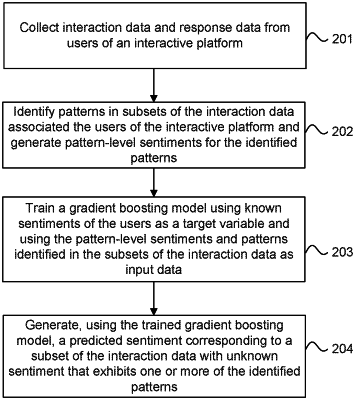| CPC G06N 5/04 (2013.01) [G06N 20/00 (2019.01)] | 20 Claims |

|
1. A method of predicting user sentiment from pattern-level sentiment, the method comprising:
identifying a first pattern and a second pattern in interaction data of an interactive platform, the first pattern corresponding to a first pattern-level sentiment generated based on a first known sentiment corresponding to response data and a subset of the interaction data exhibiting the first pattern, and the second pattern corresponding to a second pattern-level sentiment generated based on a second known sentiment corresponding to the response data and a subset of the interaction data exhibiting the second pattern, wherein the response data include one or more user responses concerning one or more user interactions included in the interaction data, and wherein the interaction data concern the one or more user interactions between one or more users and the interactive platform, and a user interaction includes a website interaction, a mobile application interaction, or a transaction card terminal interaction;
generating a first binary indicator, wherein the first binary indicator indicates whether the first pattern and the second pattern are exhibited in a first subset of the interaction data;
generating a second binary indicator, wherein the second binary indicator indicates whether the first pattern and the second pattern are exhibited in a second subset of the interaction data;
training a gradient boosting model using known sentiment as a target variable and using the first binary indicator, the second binary indicator, the first pattern-level sentiment, and the second pattern-level sentiment as input data;
generating, using the trained gradient boosting model, a predicted sentiment corresponding to a third subset of the interaction data exhibiting one or more of the first pattern or the second pattern.
|